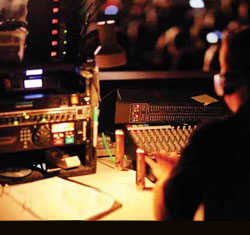Live recording is a whole lot easier in the age of digital consoles. It not only provides the means to make better board tapes, but provides a multitude of options in capturing quality 2-track and multi-track recordings that can be used for everything from virtual sound check to a product that’s ready to go to market.
In the majority of cases, a separate console isn’t needed because today’s digital boards offer plenty of processing and recording options, furthered by the routing capabilities of digital snakes and networking.
Against this backdrop, let’s take a look at a range of options—many of them quite recent—for recording in the live realm, both in terms of console capabilities as well as other interface and hardware options.
Many consoles provide basic 2-track recording to a USB stick, dedicated recorder or computer. For example, Yamaha Pro Audio MG Series mixers (analog, by the way) offer 2 x 2 connection via USB to both computers and to iPads, the latter using Apple’s camera connection kit Lightning to USB adapter.
Then there’s the ability to multi-track record right off the desk to a hard drive via USB. Recently introduced QSC TouchMix Series compact mixers offer the capability to record all tracks (22 for the TouchMix-16, 14 for the TouchMix-8) plus a stereo mix directly to USB hard drive for mixdown or import to a DAW. The Innovason Eclipse GT console with the M.A.R.S. option includes a built-in 64-track recorder that feeds directly to a hard disk plugged into the back of the console.
Allen & Heath Qu Series compact consoles offer integrated multi-track USB recorders, providing 18 channels of 48 kHz recording straight to a USB hard drive. In addition to the built-in multi-track unit, all input channels and the main L/R can be streamed via USB to a digital audio workstation (DAW) for both PC and Mac.
Mackie’s newest iPad-based mixer, the DL32R, provides two methods for multi-track recording (and playback), controlled wirelessly. The first is direct to USB hard drive, which is currently a 48 kHz, 24-input by 24-output platform that will be expanded soon to 32 x 32 via a free firmware update. An additional USB 2.0 interface is available for 32 x 32 recording and playback that can directly connect with any DAW.
“Port to Port,” a new approach incorporated in Yamaha Commercial Audio QL Series consoles, offers the ability to directly connect input ports to output ports without going through mixing channels, providing more freedom in routing signals between analog, (Audinate) Dante networking, and MY slot inputs and outputs. This provides a lot of capability—for example, mixing analog signals received at the console while directly transmitting them to a multitrack recording system via Dante.
Option cards that plug into the console or stage box are a popular, effective way to interface a variety of analog and digital protocols, as well as to pass audio to a recording device.
New PreSonus RM-series mixers include a 52 x 34 FireWire 800 recording interface and integrated Capture recording software with Virtual Soundcheck mode and Studio One Artist DAW for Mac and Windows.
The rear panel contains an option slot that comes with two FireWire 800 ports, an Ethernet control port, and S/PDIF I/O. The slot also accepts the same option cards as the StudioLive AI-series digital mixers, and with Dante, AVB, and Thunderbolt cards coming soon.






















